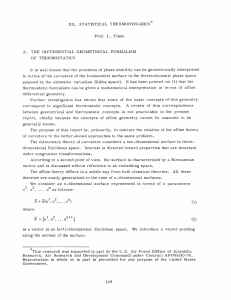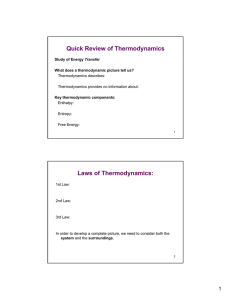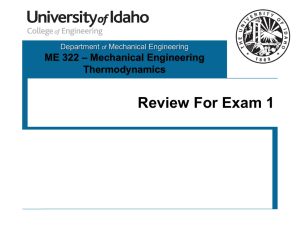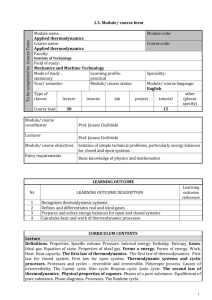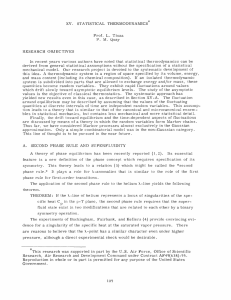XI. STATISTICAL THERMODYNAMICS* Prof. L. Tisza P.
advertisement
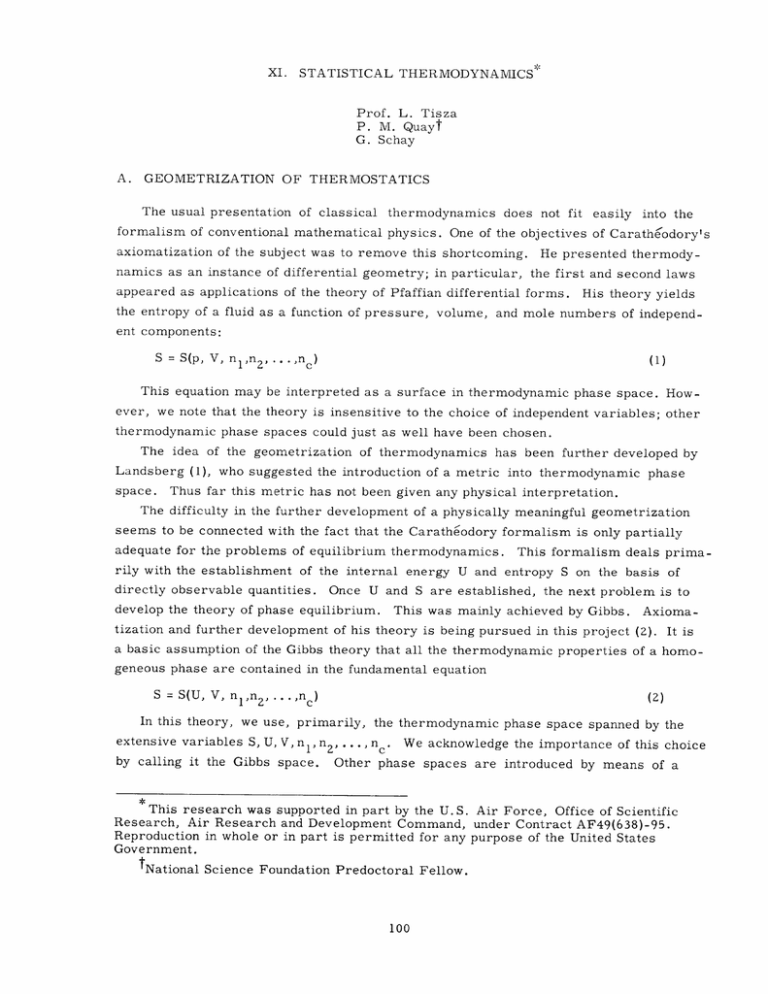
XI. STATISTICAL THERMODYNAMICS* Prof. L. Tisza P. M. Quayt G. Schay A. GEOMETRIZATION OF THERMOSTATICS The usual presentation of classical thermodynamics formalism of conventional mathematical physics. does not fit easily into the One of the objectives of Carathe odory's axiomatization of the subject was to remove this shortcoming. He presented thermody- namics as an instance of differential geometry; in particular, the first and second laws appeared as applications of the theory of Pfaffian differential forms. His theory yields the entropy of a fluid as a function of pressure, volume, and mole numbers of independent components: S = S(p, V, n1 ,n 2 .. ,..nc) (1) This equation may be interpreted as a surface in thermodynamic phase space. However, we note that the theory is insensitive to the choice of independent variables; other thermodynamic phase spaces could just as well have been chosen. The idea of the geometrization of thermodynamics has been further developed by Landsberg (1), space. who suggested the introduction of a metric into thermodynamic phase Thus far this metric has not been given any physical interpretation. The difficulty in the further development of a physically meaningful geometrization seems to be connected with the fact that the Caratheodory formalism is only partially adequate for the problems of equilibrium thermodynamics. This formalism deals prima- rily with the establishment of the internal energy U and entropy S on the basis of directly observable quantities. Once U and S are established, the next problem is to develop the theory of phase equilibrium. This was mainly achieved by Gibbs. Axioma- tization and further development of his theory is being pursued in this project (2). It is a basic assumption of the Gibbs theory that all the thermodynamic properties of a homogeneous phase are contained in the fundamental equation S = S(U, V, n1 ,n 2 , .. . nc) (2) In this theory, we use, primarily, the thermodynamic phase space spanned by the extensive variables S, U, V, nl, n2, ... ., nc. We acknowledge the importance of this choice by calling it the Gibbs space. Other phase spaces are introduced by means of a This research was supported in part by the U.S. Air Force, Office of Scientific Research, Air Research and Development Command, under Contract AF49(638)-95. Reproduction in whole or in part is permitted for any purpose of the United States Government. tNational Science Foundation Predoctoral Fellow. 100 (XI. systematic transformation theory. STATISTICAL THERMODYNAMICS) This approach yields significant results that are missed if the special role of Gibbs space is not recognized. The point that we wish to make is that the methods used for the study of phase surfaces in Gibbs space corresponds closely to the methods used in affine differential geometry. The definition of a line element by means of a metric tensor is as devoid of physical meaning as it is in the other phase spaces. However G. Pick and W. Blaschke (3) have shown that surfaces in affine space can be used to define an affine fundamental form that performs a role that is similar to the role of the metric tensor in metric geometry. The affine fundamental form associated with a phase is obtained by taking the secondorder expansion terms of the fundamental equation (Eq. 2). The matrix of this form is sometimes called the stiffness matrix (4). Along with its inverse, the compliance matrix, it plays an important role in thermodynamics; the elements of these matrices are essentially identical with the specific heat, expansion coefficient, compressibility, and the like. Thus we find a far-reaching parallel between the geometrically and thermodynamically significant quantities. An important concept of affine geometry is affine invariance: the significant relaAt least tions of the theory are invariant under linear transformation of the variables. one instance in which affine invariance can be given a physical interpretation is con- nected with the concept of independent components and can be explained in terms of an example: Consider the three chemical 2H2 + 02 = H20 allowed to proceed. species reaction This system has two independent components which can be chosen in a variety of ways: so on. H 2 , 0 2 , and H20, with the H 2 ,02; H2,H20; H,O; H, OH; O, H20; and The thermodynamic theory of the system is invariant with respect to the choice of components. However, linear transformations, the transition between the various choices is conveyed by and the aforementioned thermodynamic invariance is an instance of affine invariance. Other connections between the concepts of thermodynamics and those of affine geometry are being studied. L. Tisza References 1. For a detailed bibliography cf. the review of P. T. Landsberg, Revs. Mod. Phys. 28, 363 (1956). 2. L. Tisza, Quarterly Progress Report, Research Laboratory of Electronics, 1957, p. 167; July 15, 1957, p. 117; Jan. 15, 1958, p. 109. 3. W. Blaschke, Vorlesungen iiber Differentialgeometrie. (Julius Springer, Berlin, 1923), pp. 104, 105, 152. 4. L. Tisza, On the General Theory of Phase Transitions; Phase Transformations in Solids by Smoluchowski, Mayer and Weyl (John Wiley and Sons, Inc., New York, 1951), p. 1. 101 M.I. T., April 15, II. Affine Differentialgeometrie
